The cherry barb (Puntius titteya) is a vibrant and charming addition to any aquarium, renowned for its striking colors and lively nature. As one of the most popular species of barbs, cherry barbs are celebrated for their peaceful temperament and active behavior, making them a great choice for both novice and seasoned aquarists. In the following sections, you’ll learn how to properly care for cherry barbs, including tips on their diet, choosing compatible tank mates, and breeding. Understanding these aspects will help ensure your cherry barbs thrive and add beauty to your aquatic setup.
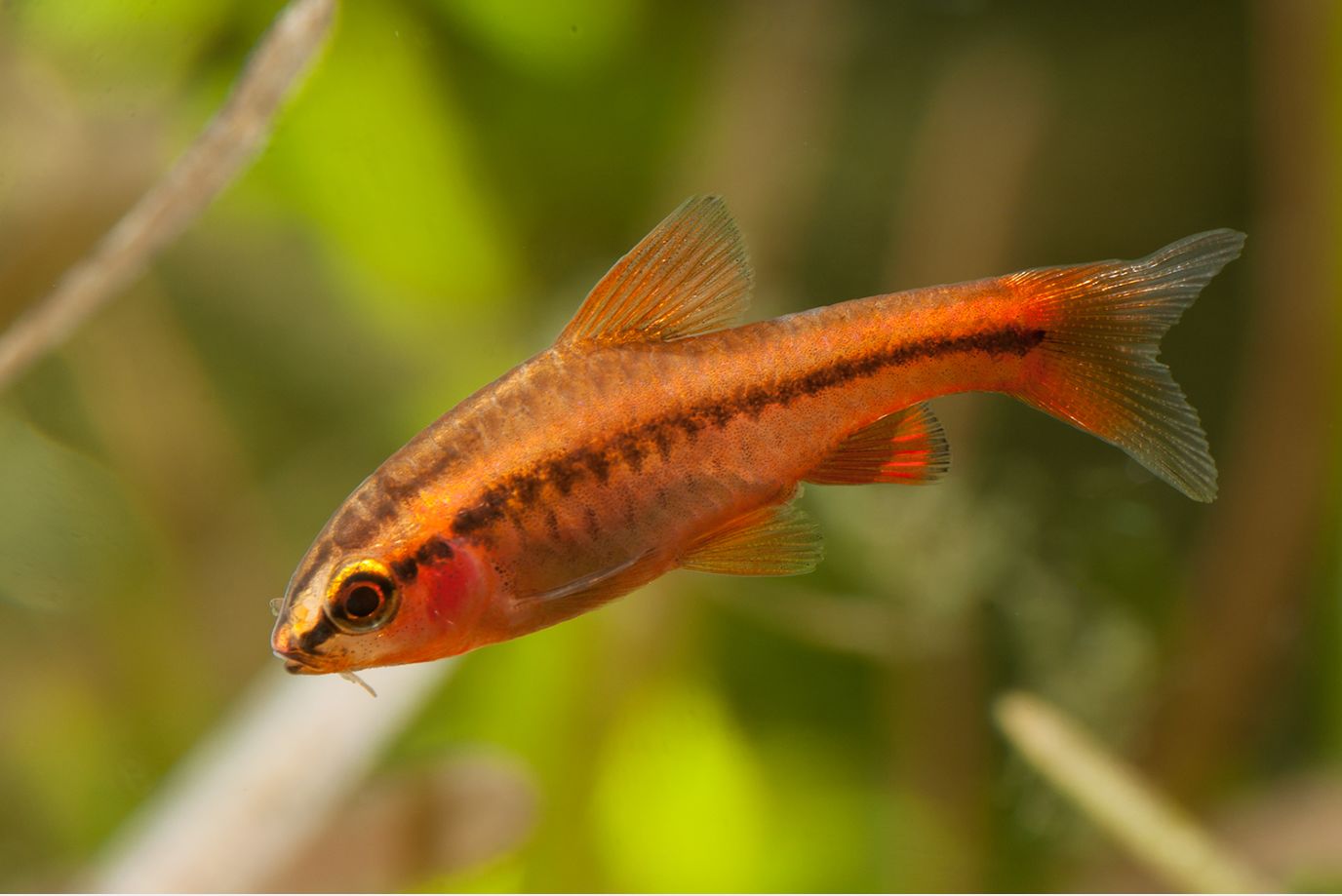
Contents
Habitat in the wild
The cherry barb (Puntius titteya) is native to the freshwater ponds of southwestern Sri Lanka, particularly in the Kelani and Nilwala river valleys. In these regions, cherry barbs thrive in shaded streams and small rivers with muddy bottoms, abundant plant matter, and intricate drainage systems. They are commonly found in shallow, clear to slightly tinted waters.
In their natural environment, cherry barbs prefer slow-moving, heavily vegetated waters with dense plant growth and leaf litter. They thrive in habitats with moderate to strong water flow and are often seen around submerged roots and thick vegetation, which provide ample hiding spots. The water in these streams is typically low in light penetration due to dense cover, with temperatures ranging from 23°C to 27°C, hardness (dH) between 5 and 19, and pH levels between 6.0 and 7.5.
The pond bottoms are generally sandy, covered with a layer of decaying leaves and branches. Although the export of wild cherry barbs from Sri Lanka is now prohibited, illegal capture continues, leading to a decline in their vibrant coloration in the wild. This decrease is attributed to the selective capture of the most brightly colored individuals.
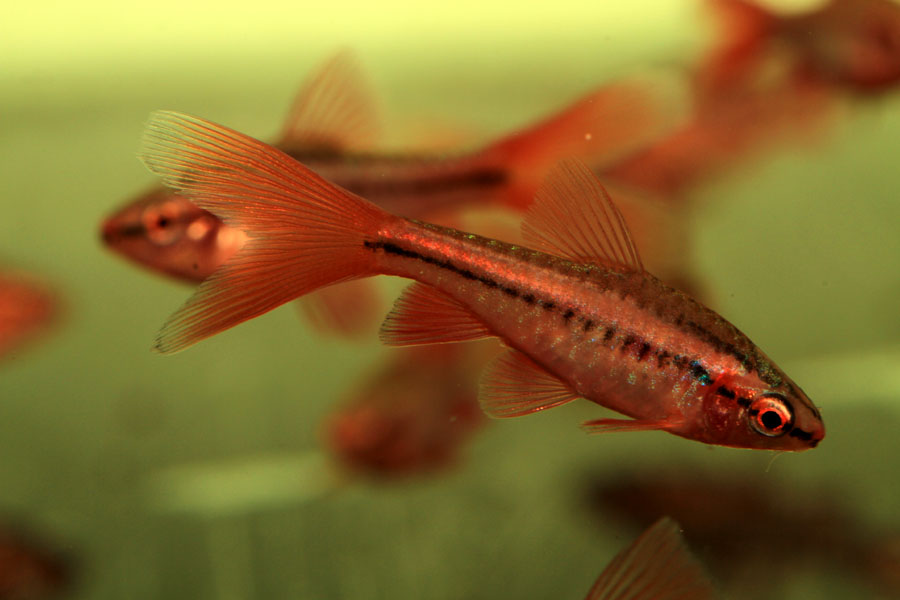
Description
It has elongated body, its back profile is rather curved, and lateral line isn’t complete. The fish has inferior mouth and one pair of barbs. Male has brown-green back and reddish or body bottom which is separated from the body sides with brown-red lateral line. The fish iris is bloody-red on top. Female abdomen is whitish, the back is yellow-gray and lateral line is also brown-red. The fins color varies from yellowish to red.
Albino cherry barb
In captivity, you may encounter a unique variant known as the albino cherry barb. This type of cherry barb (Puntius titteya) features a striking white or pale pinkish body coloration, a result of a genetic mutation that eliminates the typical pigmentation found in the standard cherry barb. This genetic variation gives the albino cherry barb its distinctive and eye-catching appearance.
Despite their different coloration, albino cherry barbs share the same care requirements and general characteristics as their non-albino counterparts. They thrive under similar conditions and benefit from the same tank setup, diet, and tank mates. Whether you choose the traditional or albino variety, both offer the same level of charm and ease of care for aquarium enthusiasts.
Longfin or veiltail cherry barb
The longfin cherry barb is a selectively bred variant of the standard cherry barb (Puntius titteya). This elegant fish is distinguished by its long, flowing fins, which give it a more graceful and sophisticated appearance compared to its shortfin relatives. The extended fins add a touch of beauty and fluidity as the fish swims, making it a striking addition to any aquarium.
Despite these visual differences, the care requirements and general characteristics of longfin cherry barbs are quite similar to those of the standard cherry barb. Both types thrive under the same conditions and benefit from similar tank setups, diets, and compatible tank mates. Whether you prefer the classic or longfin variety, both offer the same ease of care and charm, making them excellent choices for aquarium enthusiasts.
Size
Cherry barb body size of around 1.5 to 2 inches (3.8 to 5 centimeters) in length, it’s a small fish. Males tend to be slightly smaller and more slender than females. It’s important to note that individual fish sizes can vary, and factors such as genetics, diet, and overall health can influence their growth.
Lifespan
In captivity, cherry barbs typically have a lifespan of about 4 to 5 years. However, with meticulous care and optimal tank conditions, some individuals have been known to live up to 6 years or even longer. To maximize their longevity, it is crucial to provide a well-maintained aquarium with stable water parameters, a balanced and nutritious diet, and a stress-free environment. By ensuring these factors, you can help your cherry barbs thrive and enjoy a longer, healthier life.
| Characteristic | Description |
|---|---|
| Scientific Name | Puntius titteya |
| Common Name | Cherry Barb |
| Native Habitat | Sri Lanka, rivers and streams |
| Size | 1.5 to 2 inches (3.8 to 5 centimeters) |
| Body Color | Males: reddish-brown body with red fins and black dorsal spot; Females: silvery |
| Lifespan | 3 to 5 years (up to 76 years with proper care) |
| Tank Size | Minimum 10 gallons |
| Water Temperature | 72°F to 79°F (22°C to 26°C) |
| Water pH | 6.0 to 7.5 |
| Compatibility | Peaceful, suitable for community aquariums |
| Diet | Omnivorous, flake or pellet food, supplemented with live or frozen foods |
| Behavior | Peaceful, active swimmers, schooling behavior |
| Breeding | Separate breeding tank, spawning medium or plants, slightly softer and more acidic water conditions |
Difficulties in keeping
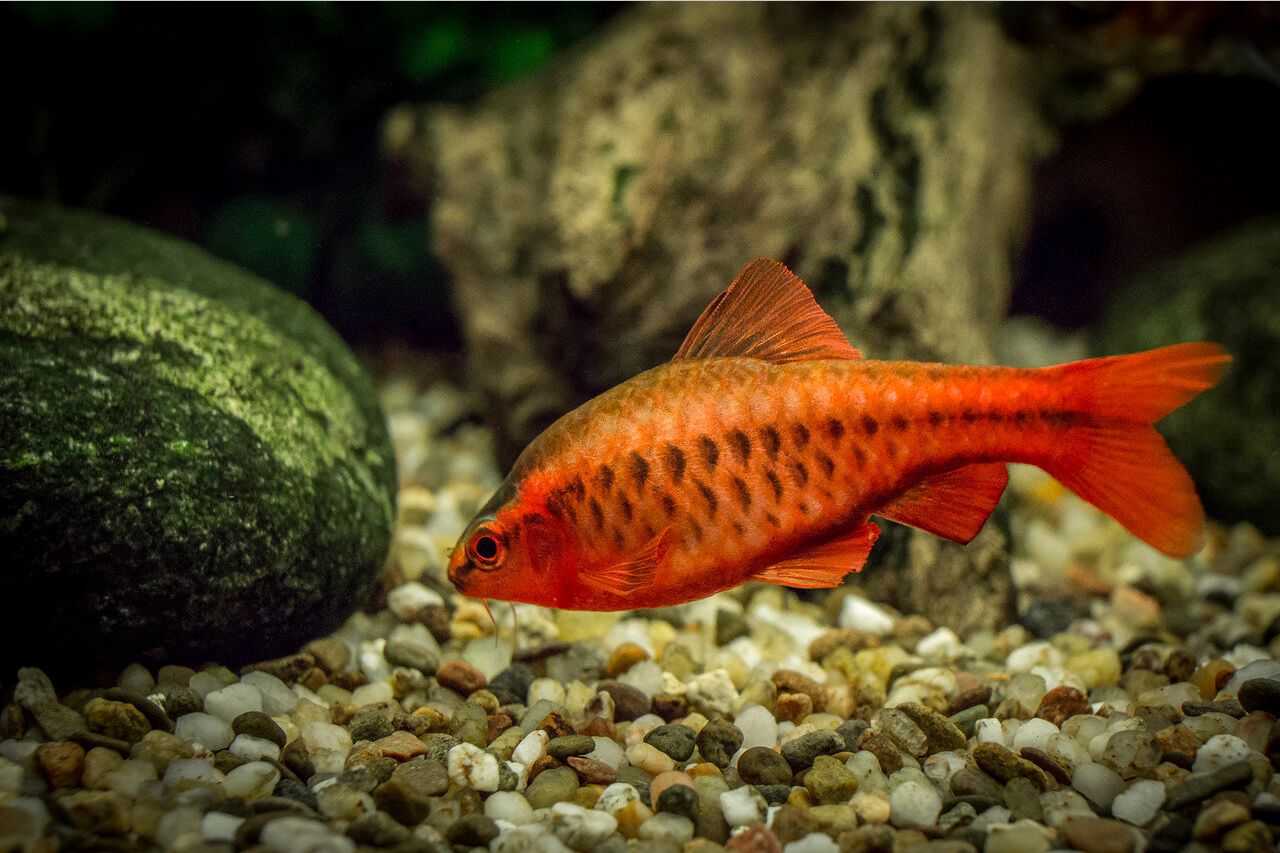
Care and keeping in a tank
Tank size
Cherry barbs are schooling fish and thrive best when kept in groups of 6 to 10 individuals. Keeping them in such numbers helps reduce stress and makes them less timid. Additionally, males exhibit more vibrant coloration when surrounded by rivals. The recommended minimum tank size for a small group of cherry barbs is 10 gallons (37.8 liters). This size provides enough space for the fish to swim and thrive comfortably.
However, larger tanks are preferable as they offer more stability and additional swimming space. If you plan to keep a larger group or include other fish species, a bigger tank is advisable. Providing ample swimming space and territory helps reduce stress and minimizes aggression.
For optimal conditions, choose a tank with more horizontal swimming space rather than a tall, narrow one, as cherry barbs are active swimmers. Ensure good water filtration and maintain a gentle water flow to create a suitable environment for these lively fish.
Tank decor
Choice of tank decorations isn’t a crucial factor, although cherry barb becomes brighter in a thickly planted tank with dark bottom substrate. It’s desirable to add some fluctuant and snags into the tank. The tank should be thickly planted since cherry barb is rather timid fish and they need a possibility to hide in the plants. However, you should leave some free, not planted area in the tank, where the fish can swim. As a rule the cherry barb swims in the middle and bottom water layers.
As we’ve already mentioned, tank mates should be peaceful, since this one is a peaceful, too.
Water parameters
Cherry barbs are relatively adaptable to various water parameters, but maintaining optimal conditions is crucial for their health and well-being. Here are the recommended water parameters for cherry barbs:
- Temperature: Maintain the water temperature between 72°F and 79°F (22°C to 26°C) to closely match their natural habitat in Sri Lanka.
- pH Level: Cherry barbs thrive in a slightly acidic to neutral pH range of 6.0 to 7.5. Keeping the pH stable within this range will provide a comfortable environment for them.
- Water Hardness: While cherry barbs can tolerate a range of water hardness levels, they prefer slightly softer water. Aim for a general hardness (GH) of 5 to 12 degrees and a carbonate hardness (KH) of 2 to 8 degrees.
- Ammonia, Nitrite, and Nitrate Levels: Regularly test and maintain low levels of ammonia, nitrite, and nitrate. Ammonia and nitrite should ideally be undetectable, while nitrate should be kept below 20 parts per million (ppm) to ensure a healthy environment.
Filtration
To achieve and maintain these water parameters, proper filtration and regular water changes are essential. Using a high-quality filter helps remove waste and keep the water clean. Regular water changes are crucial for replenishing essential minerals and maintaining overall water quality.
Additionally, routinely test the water parameters with a reliable test kit. This will enable you to monitor and adjust the conditions as needed to ensure a stable and healthy environment for your cherry barbs.
Tank mates
Cherry barbs are generally peaceful and can coexist with a variety of other peaceful fish species in a community aquarium. Unlike lots of its relatives cherry barb behavior is very peaceful and calm. They don’t even touch long finned fishes.
It’s an ideal fish for community tanks, but it has to be kept with fishes of the same small size. Small and helpless cherry barb will be an easy prey for any predator fish. For example, angelfish is rather large and aggressive tank mate. However, cherry barb won’t attack them, but they may do this. It’s good to keep it with tetras. Cherry barb is also tolerant towards any shrimps, even so small as cherry shrimp.
Here are some popular tank mates that can be suitable companions for cherry barbs:
- Harlequin Rasboras (Trigonostigma heteromorpha)
- Neon Tetras (Paracheirodon innesi)
- Ember Tetras (Hyphessobrycon amandae)
- Glowlight Tetras (Hemigrammus erythrozonus)
- Black Neon Tetras (Hyphessobrycon herbertaxelrodi)
- Cardinal Tetras (Paracheirodon axelrodi)
- Rummy Nose Tetras (Hemigrammus rhodostomus)
- Dwarf Gouramis (Trichogaster lalius or Trichogaster chuna)
- Sparkling Gouramis (Trichopsis pumila)
- Celestial Pearl Danios (Danio margaritatus)
- White Cloud Mountain Minnows (Tanichthys albonubes)
- Dwarf Rasboras (Boraras spp.)
- Endler’s Livebearers (Poecilia wingei)
- Guppies (Poecilia reticulata)
- Platies (Xiphophorus spp.)
- Corydoras Catfish (Corydoras spp. – pygmy cory, panda cory, adolfoi catfish)
- Otocinclus Catfish (Otocinclus spp.)
- Bristlenose Plecos (Ancistrus spp.)

Diet
Cherry barbs are not particularly demanding eaters and will consume a variety of foods. However, due to their small size, they may struggle with large-grained food.
A staple diet of high-quality flake or pellet food designed for tropical fish is ideal for cherry barbs. Choose a reputable brand that offers a well-balanced mix of protein, vitamins, and minerals. To enhance their diet, supplement with live or frozen foods. Cherry barbs particularly enjoy small live or frozen options such as brine shrimp, bloodworms, daphnia, and mosquito larvae.
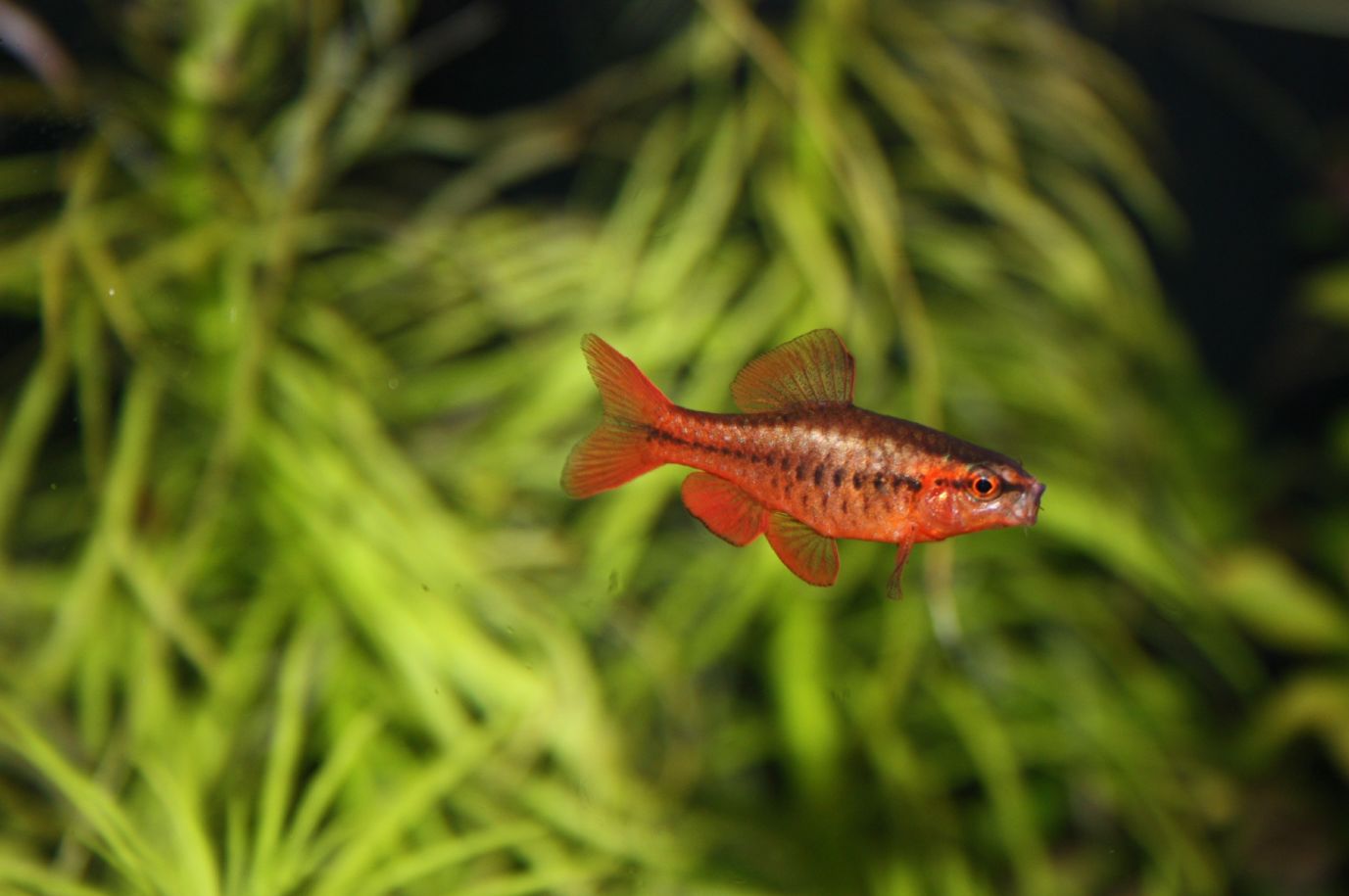
Gender differences: male vs female
Distinguishing between male and female cherry barbs can be challenging when they are young. However, as they mature and become reproductive, the differences become more apparent. Females develop a rounder, fuller abdomen, while males remain slimmer and exhibit more vibrant coloration. Males display their brightest colors especially during breeding season or when courting females.
Male cherry barbs also engage in what can be described as display fights. These are not actual physical confrontations but rather displays of their most vivid colors and active behaviors. Males often show increased activity and assertiveness during these displays, either to establish dominance or attract potential mates.
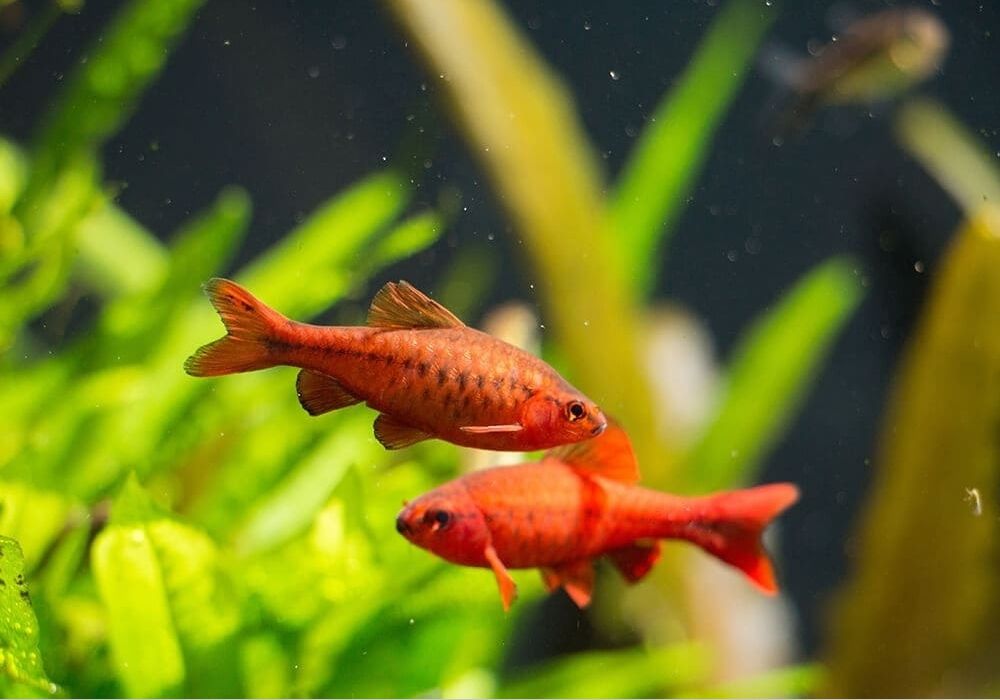
Breeding
For spawning cherry barbs, you can use a small tank, about 20-25 cm (8-10 in) in length, filled with a small amount of water. Maintain the water temperature between 26-28°C (78-82°F) for optimal conditions.
It is essential to include tank plants, as they provide hiding spots for the eggs. Before introducing the fish, separate the males and females for 7-10 days and feed them a nutritious diet. You may also refresh a portion of the tank water and slightly increase the temperature. An ideal male-to-female ratio in the spawning tank is 2:1.
After spawning, typically occurring in the morning, remove the adult fish from the tank and provide a shaded environment for the eggs. The incubation period for the eggs lasts 36-48 hours. The larvae will develop into juveniles within 2-3 days. At this juvenile stage, the fish will measure approximately 1.2-1.8 cm long and will continue to grow over a period of 45-60 days.